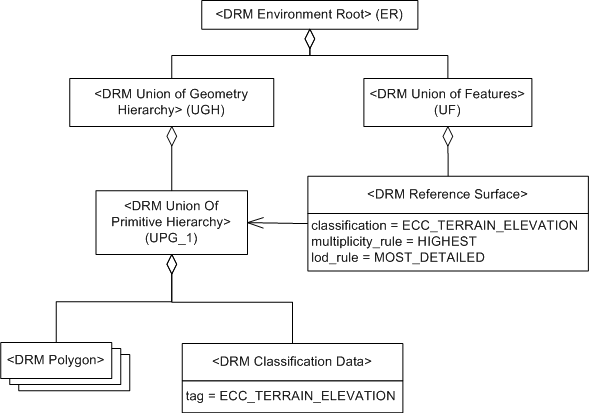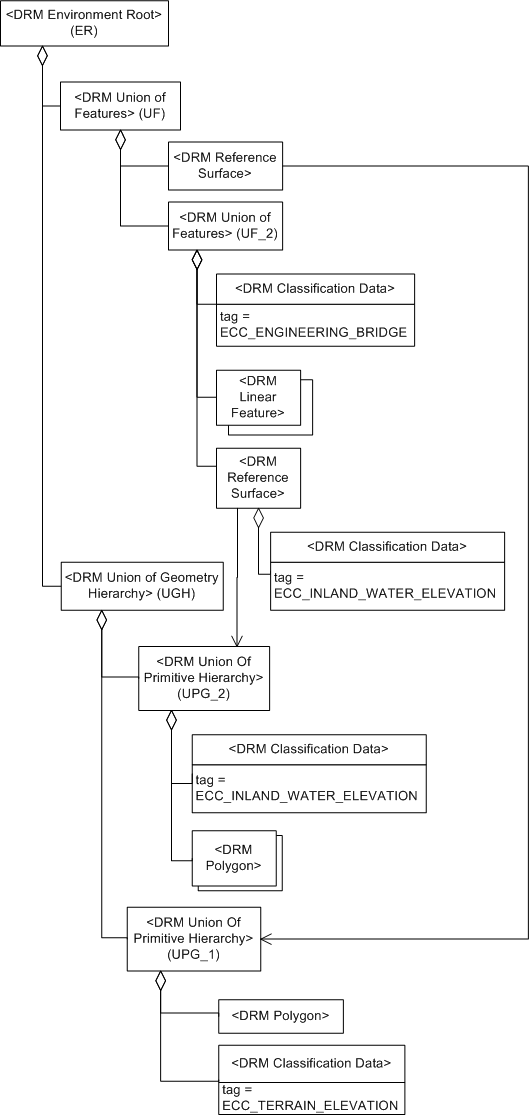An instance of this DRM class specifies a constructed, geometric
surface that is part of the environment. The <Reference Surface>
instance is used to determine the elevation of conforming points in the
component tree rooted at each hierarchy instance of which it is a
component. Conforming points are either <Location 2D> instances
or <Location Surface> instances. A <Reference Surface>
instance also specifies how the surface is used in determining the
elevation value.
The third coordinate-component of a conforming point is determined
as specified in 4.7.3 Location of ISO/IEC 18023-1.
Consider an <Environment Root> instance ER,
having both a <Union Of Geometry Hierarchy> component
UGH and a <Union Of Features> component
UF.
UGH contains a <Union Of Primitive Geometry>
instance UPG_1 classified as ECC_TERRAIN_ELEVATION
and containing <Polygon> components that inherit the
<Classification Data> instance. UPG_1 is a
polygonal representation of terrain, forming part of the
larger environmental representation ER.
UF, the feature representation of
ER, has a <Reference Surface>
component that associates to UPG_1 as
depicted in Figure 53:

Figure 53 — <DRM Reference Surface> ECC_TERRAIN_ELEVATION example
Consequently, conforming points found in the component tree of
UF use the terrain polygons of
UPG_1 to resolve elevation.
Continuing the previous example, the
<Union Of Geometry Hierarchy> instance UGH
under ER contains another
<Union Of Primitive Geometry> instance
UPG_2 with <Polygon> components
classified as ECC_INLAND_WATER_ELEVATION as depicted in
Figure 54.

Figure 54 — <DRM Reference Surface> ECC_INLAND_WATER_ELEVATION example
UF, in turn, has a <Union Of Features>
component UF_2 that is classified as
ECC_ENGINEERING_BRIDGE and contains
<Linear Feature> instances using
<Location 2D> instances. UF_2 also has
a <Reference Surface> component with
classification =
ECC_INLAND_WATER_ELEVATION and associated to
UPG_2.
Consequently, the conforming points of UF_2 have
elevation values derived for them by being evaluated against
UPG_2.
Consider a <Reference Surface> instance
R for which the geometry is a
<Spatial Index Related Geometry> instance
S. Each branch of S
is a polygonal representation, part of which represents
terrain surface, part roads, and part forest canopy.
R associates to S,
and its classification field =
ECC_TERRAIN_ELEVATION. The resolution process then ignores
the road and canopy polygons, but sees all the terrain polygons
regardless of which union they are in.
Consider a <Linear Feature> instance L
representing a road that mostly stays on the road geometry but
sometimes strays off. L is placed in a
<Union Of Features> instance aggregating a different
<Reference Surface> instance R2
with associates to the same
<Spatial Index Related Geometry> instance but has
classification = ECC_ROAD.
Like R, R2 associates
to S. The resolution process for
R2 sees the road <Polygon>
instances and ignores the others. For <Feature Node>
instances that stray off the road, the corresponding
conforming points' rays fail to intersect any road polygon, so the
resolution process (as per case 3) applies, and the
resolution process falls back on the previous override,
which was the terrain surface.
Consider a terrain representation organized in three-minute regions that
are grouped into one-degree cells. The cells are all collected under one
<Union Of Geometry Hierarchy> instance. In the same transmittal,
<Feature Representation> instances and non-terrain
<Geometry Representation> instances are organized under a
corresponding spatial organization. Each three-minute hierarchy has a
<Reference Surface> instance associated to the
corresponding three-minute terrain region. Each one-degree hierarchy has a
<Reference Surface> instance associated to the
corresponding one-degree terrain cell. Each of the highest level feature
and non-terrain geometry hierarchies has a
<Reference Surface> instance associated to the
terrain <Geometry Hierarchy> instance.
In this scheme, a <Location 2D> instance in a
three-minute region finds its resolution surface in the corresponding
three-minute terrain region. If a <Location 2D> instance
is outside its region (i.e.,
strict_organizing_principle
= SE_FALSE),
the containing one-degree terrain cell resolves the conforming point.
If the location ray fails to intersect the one-degree terrain cell,
the full terrain <Union Of Geometry Hierarchy> instance
is used. If ray / surface intersection still fails, the elevation
is resolved by the designated spatial surface.
-
Why does a hierarchy need a <Reference Surface>
instance? What is meant by "elevations" for
conforming points? They don't have elevation.
In a 3D SRF, conforming points are thought of as lying on a surface.
Which surface is intended seems to be subjective at best. A
cartographer may prefer the designated spatial surface as the
conforming point surface, while others prefer the
"terrain surface". Terrain surface is also a subjective term,
and terrain surfaces have been mapped to the DRM in a variety of ways.
Even if one notion of surface for conforming points were mandated,
it would not meet everyone's requirements.
The solution is to mandate a clearly defined surface (the initial
default) and provide a flexible mechanism to override the
default for all or for selected parts of the transmittal.
-
How does a <Feature Hierarchy> instance or
<Geometry Hierarchy> instance use a
<Reference Surface> instance to resolve elevations for
conforming points within their component trees?
Consider a <Reference Surface> instance that is associated to a
<Geometry Hierarchy> instance that contains a surface. A
conforming point corresponds to the (unique) ray which is:
normal to the surface of the SRF's ORM (*),
intersects the ORM at the same horizontal coordinates as the
conforming point, and
extends below the surface of the ORM to a depth
equal to the minor radius of the ORM, if the ORM is an ellipsoid.
(*) NOTE:
For augmented Projected SRFs, this is the projection ellipsoid. For LSR,
use the z=0 plane, where z is the coordinate axis specified by the
SRM_LSR_3D_Parameters
up_direction value.
The intersection of this ray with the resolution surface defines the
candidate set for the corresponding 3D location. One 3D location is
selected from the ray/surface intersection set according to the
following three cases.
If the set contains one and only one element, the spatial position
of that point resolves the conforming point instance.
If the set contains more than one element, the
multiplicity_rule
value is used to select exactly one element.
(For example, if several overlapping <Property Grid> instances
with <Grid Overlap> components are part of the
<Reference Surface> instance, use
<Grid Overlap> component's rules to define the
<Reference Surface> instance in the
overlap region of two or more of the surface grids. If the
intersection set still has more than one point, use
multiplicity_rule.)
If the intersection is empty, look for other
<Reference Surface> instances higher up the component tree
and repeat this resolution process with that surface instead. If
there are no other <Reference Surface> instances higher up
the component tree, use the designated spatial surface
(which is guaranteed to be a case 1 surface).
(See also example 5).
-
What if there is no single <Union Of Primitive Geometry>
instance that defines the <Reference Surface> instance?
There is no requirement that the aggregate be free of non-reference
surface geometry (See example 3). In this case, find the higher level
<Geometry Hierarchy> instance that aggregates the desired
<Union Of Primitive Geometry>
sub-hierarchies, and use that for the
<Reference Surface> association.
-
What happens to <LSR 2D Location> instances
in an LSR <Model> instance M when
M is instanced by a model instance object in
a non-LSR 3D SRF?
That depends on whether or not the scoping SRF supports
conforming points.
If conforming points are supported in the scoping SRF, (for example,
if the scoping SRF is 3D geodetic, for which 2D geodetic exists),
these conforming points are converted to conforming points in the
instancing 3D SRF using a 3 step process.
-
Otherwise, if the scoping SRF does not support conforming points,
the <LSR 2D Location> instance is
converted to 3D by setting the tertiary axis value to zero.
(Note 1): LSR models are not permitted to contain
<Reference Surface> instances;
see constraints.
(Note 2): Conformal behaviour may also be modelled with
<LSR 3D Location Control Link>
instances.
-
Can a <Geometry Model Instance> instance be used for a
<Reference Surface> instance's association?
Yes, if the <Model> instance's SRF
matches the currently scoped SRF.
-
How are conforming points converted consuming data in a different SRF?
There are two cases.
Case 1 - both SRFs have the same ORM.
Case 2 - The two SRFs have different ORMs.
In case 1 (Same ORM), the ray determined by the conforming point
is invariant, so the horizontal coordinates are converted in the
usual way.
In case 2 (Different ORMs), the ray may change, so three
steps are needed:
| Step 1 |
Resolve elevation in the originating SRF and convert the
conforming point to a <Location 3D> instance.
|
|---|
| Step 2 |
Convert the <Location 3D> instance to the
second SRF (conversion not currently supported).
|
|---|
| Step 3 |
Collapse the <Location 3D> instance to a conforming point.
|
|---|
-
If a transmittal is consumed in an SRF other than its native
SRF, should elevations be resolved in the originating or the
consuming SRF?
It should not make a difference if the two SRFs are both
"real world" or
both Augmented Projected Coordinate Systems (APCS). In the case in which
one is "real" world and the other is APCS, there are
two ways to deal with the "conversion distortion" that
tends to bend flat surfaces.
Consider a conforming point whose ray intersects the resolution surface
near the centre of exactly one triangular <Polygon> instance.
The intersection point determines the elevation, and therefore a
corresponding <Location 3D> instance. If elevations are
resolved in the first SRF, and the <Location 3D> instance
is then converted, the location will match the transmittal point,
but it may no longer lie on the triangle's surface. On the other hand,
if the conforming point is converted and then elevations are resolved
in the second SRF, the corresponding <Location 3D> instance
will lie on the triangle's surface, but may differ a little in
elevation from the originating point. Therefore if absolute location
is more important than conformality, resolve in the originating SRF.
If conformality is more important, resolve in the consuming SRF.
Within the reference surface, only geometry matching
the (possibly elaborated) classification specified by the
classification
field is used.

